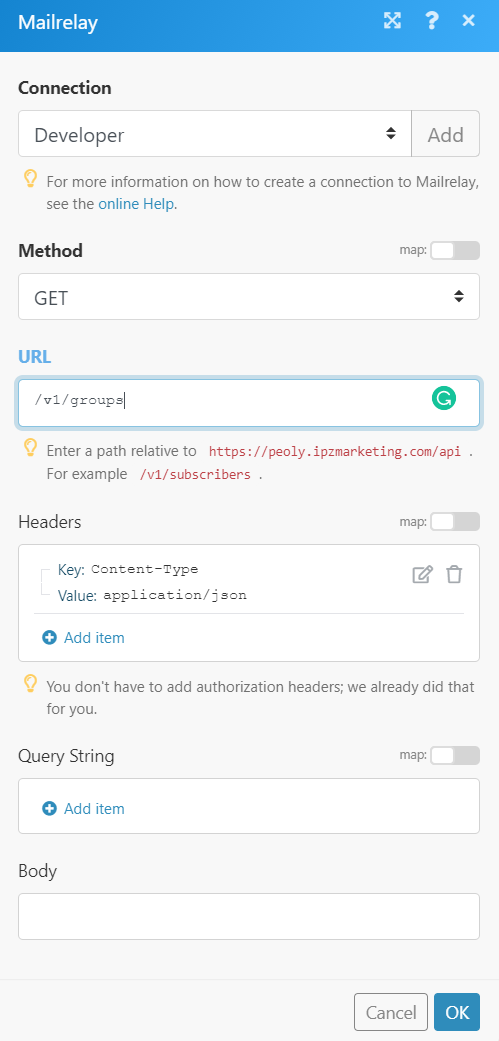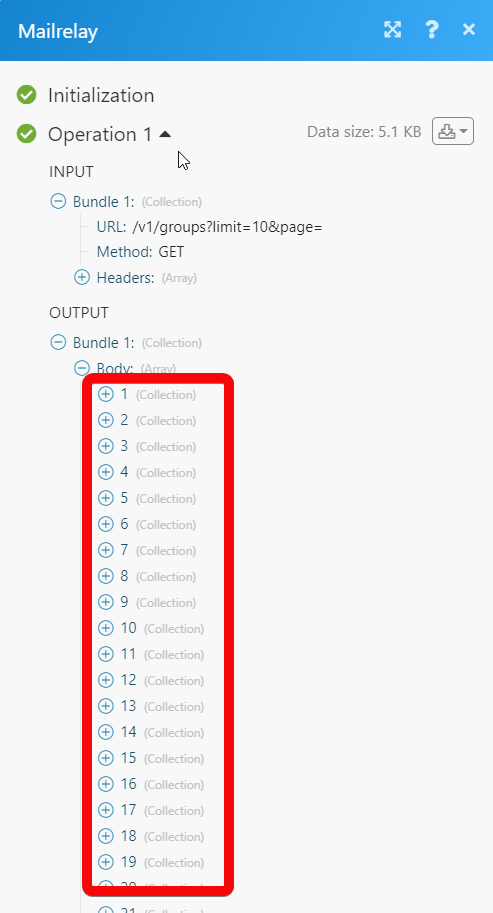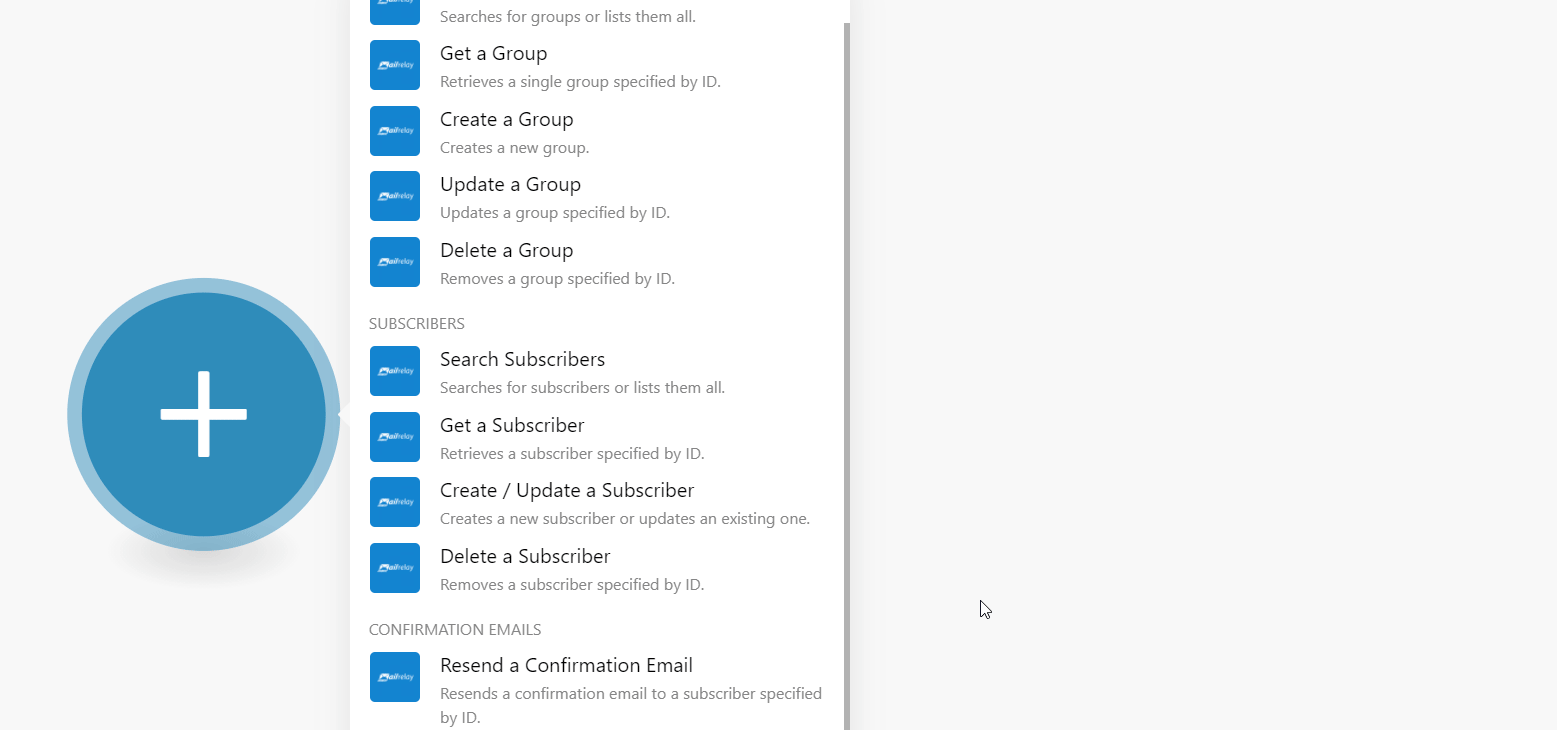| Active with remarks |
|---|
| This application needs additional settings. Please follow the documentation below to create your own connectionUnique, active service acces point to a network. There are different types of connections (API key, Oauth…). More. |
The Mailrelay modulesThe module is an application or tool within the Boost.space system. The entire system is built on this concept of modularity. (module - Contacts) More allow you to monitor, create, update, send, retrieve, list, and delete the groups and subscribers in your Mailrelay account.
Prerequisites
-
A Mailrelay account – create an account at mailrelay.com/en/.
The moduleThe module is an application or tool within the Boost.space system. The entire system is built on this concept of modularity. (module - Contacts) More dialog fields that are displayed in bold (in the Boost.spaceCentralization and synchronization platform, where you can organize and manage your data. More IntegratorPart of the Boost.space system, where you can create your connections and automate your processes. More scenarioA specific connection between applications in which data can be transferred. Two types of scenarios: active/inactive. More, not in this documentation article) are mandatory!
To connect your Mailrelay account to Boost.space Integrator you need to obtain the API Key from your Mailrelay account and insert it in the Create a connection dialog in the Boost.space Integrator module.
-
Log in to your Mailrelay account.
-
Click Settings > API Keys.
-
Copy the tokenThe API token is a multi-digit code that allows a user to authenticate with cloud applications. More to your clipboard.
-
Go to Boost.space Integrator and open the Mailrelay module’s Create a connection dialog.
-
In the Connection name field, enter a name for the connection.
-
In the API Key field, enter the token copied in step 3.
-
In the Domain field, enter your organization domain within Mailrelay. For example, if your account’s URL is
https://xyz.ipzmarketing.comthen the domain isxyz. -
Click Continue.
The connection has been established.
Searches for groups or lists them all.
|
Connection |
|
|
Search Criteria |
Select or map the search criteria and enter its value to filter the groups that match the specified ID. |
|
Limit |
Set the maximum number of groups Boost.space Integrator should return during one execution cycleA cycle is the operation and commit/rollback phases of scenario execution. A scenario may have one or more cycles (one is the default).. |
Retrieves a single group specified by ID.
|
Connection |
|
|
Group ID |
Select or map the Group ID whose details you want to retrieve. |
Creates a new group.
|
Connection |
|
|
Name |
Enter (map) a name for the group. |
|
Description |
Enter (map) the details of the group. |
Updates a group specified by ID.
|
Connection |
|
|
Group ID |
Select or map the Group ID you want to update. |
|
Name |
Enter (map) a new name for the group. |
|
Description |
Enter (map) the new details of the group. |
Removes a group specified by ID.
|
Connection |
|
|
Group ID |
Select or map the Group ID you want to delete. |
Searches for subscribers or lists them all.
|
Connection |
|
|
Search Criteria |
Select or map the search criteria and enter its value to filter the groups that match the specified ID. |
|
Include Groups |
Select whether you want to include the groups in the results. |
|
Filter by StatusCreate statuses for each module separately to create an ideal environment for efficient and consistent work. More |
Select or map the status to filter the subscribers that match the specified status:
|
|
Banned |
Select whether you want to list the banned subscribers. |
|
Bounced |
Select whether you want to list the bounced subscribers. |
|
Reported Spam |
Select whether you want to list the subscribers that reported spam. |
|
Unsubscribed |
Select whether you want to unsubscribed subscribers. |
|
Group IDs |
Select or map the Group IDs to list the subscribers that belong to the specified groups. |
|
Limit |
Set the maximum number of groups Boost.space Integrator should return during one execution cycle. |
Retrieves a subscriber specified by ID.
|
Connection |
|
|
Subscriber ID |
Select or map the Subscriber ID whose details you want to retrieve. |
|
Include Groups |
Select whether you want to include subscriber group details in the results. |
Creates a new subscriber or updates an existing one.
|
Connection |
|
|
Email Address |
Select or map the email address of the subscriber whom you want to create or update. |
|
Status |
Select or map the subscriber status:
|
|
Replace Groups |
Select whether you want to replace the subscriber group. |
|
Restore if Deleted |
Select whether you want to restore the subscriber if it is deleted. |
|
Name |
Enter (map) the subscriber’s name. |
|
Address |
Enter (map) the subscriber’s address. |
|
City |
Enter (map) the subscriber’s city name. |
|
State |
Enter (map) the subscriber’s state name. |
|
Country |
Enter (map) the subscriber’s country name. |
|
Birthday |
Enter (map) the subscriber’s date of birth. |
|
Website |
Enter (map) the subscriber’s website URL address. |
|
Group IDs |
Select or map the Group IDs to which you want to add the subscriber. |
Removes a subscriber specified by ID.
|
Connection |
|
|
Subscriber ID |
Select or map the Subscriber ID whose details you want to delete. |
Resends a confirmation email to a subscriber specified by ID.
|
Connection |
|
|
Subscriber ID |
Select or map the Subscriber ID to whom you want to send the confirmation email. |
Performs an arbitrary authorized API call.
|
Connection |
||||
|
URL |
Enter a path relative to
|
|||
|
Method |
Select the HTTP method you want to use: GET to retrieve information for an entry. POST to create a new entry. PUT to update/replace an existing entry. PATCH to make a partial entry update. DELETE to delete an entry. |
|||
|
Headers |
Enter the desired request headers. You don’t have to add authorization headers; we already did that for you. |
|||
|
Query String |
Enter the request query string. |
|||
|
Body |
Enter the body content for your API call. |
The following API call returns all the groups from your Mailrelay account:
URL:
/v1/groups
Method:
GET

Matches of the search can be found in the module’s Output under BundleA bundle is a chunk of data and the basic unit for use with modules. A bundle consists of items, similar to how a bag may contain separate, individual items. More > Body.
In our example, 30 groups were returned:





![[Note]](https://docs.boost.space/wp-content/themes/bsdocs/docs-parser/HTML/css/image/note.png)